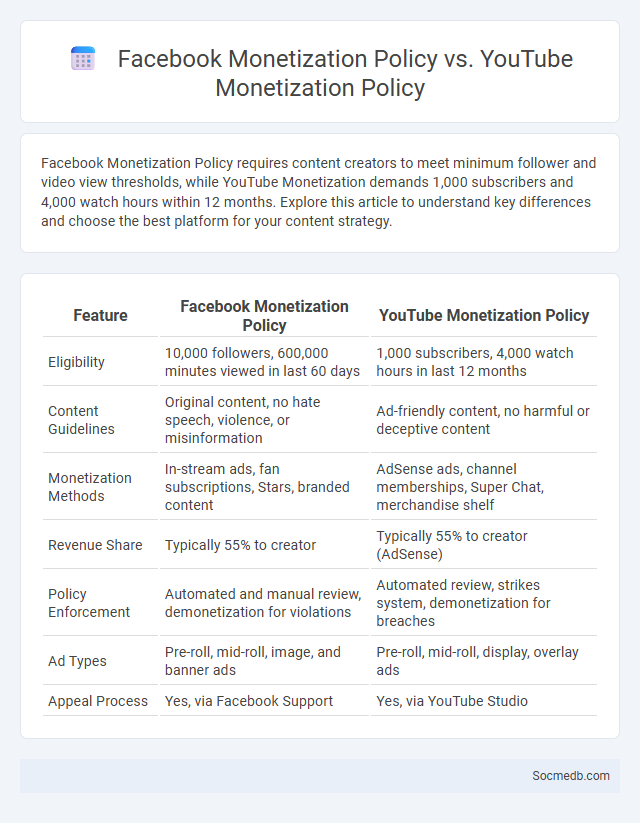
Photo illustration: Facebook Monetization Policy vs YouTube Monetization Policy
Facebook Monetization Policy requires content creators to meet minimum follower and video view thresholds, while YouTube Monetization demands 1,000 subscribers and 4,000 watch hours within 12 months. Explore this article to understand key differences and choose the best platform for your content strategy.
Table of Comparison
| Feature | Facebook Monetization Policy | YouTube Monetization Policy |
|---|---|---|
| Eligibility | 10,000 followers, 600,000 minutes viewed in last 60 days | 1,000 subscribers, 4,000 watch hours in last 12 months |
| Content Guidelines | Original content, no hate speech, violence, or misinformation | Ad-friendly content, no harmful or deceptive content |
| Monetization Methods | In-stream ads, fan subscriptions, Stars, branded content | AdSense ads, channel memberships, Super Chat, merchandise shelf |
| Revenue Share | Typically 55% to creator | Typically 55% to creator (AdSense) |
| Policy Enforcement | Automated and manual review, demonetization for violations | Automated review, strikes system, demonetization for breaches |
| Ad Types | Pre-roll, mid-roll, image, and banner ads | Pre-roll, mid-roll, display, overlay ads |
| Appeal Process | Yes, via Facebook Support | Yes, via YouTube Studio |
Overview of Facebook Monetization Policy
Facebook's monetization policy outlines specific criteria for content creators to earn revenue through features like in-stream ads, fan subscriptions, and brand collaborations. Eligibility requires adherence to community standards, original content creation, and meeting engagement thresholds such as follower count and video view durations. The policy emphasizes transparency, prohibits monetization on harmful or misleading content, and enforces strict compliance to maintain a safe advertising environment.
Overview of YouTube Monetization Policy
YouTube monetization policy requires creators to comply with community guidelines, copyright rules, and advertiser-friendly content standards to qualify for revenue sharing. Channels must have at least 1,000 subscribers and 4,000 watch hours within the past 12 months to apply for the YouTube Partner Program. Monetization options include ads, channel memberships, Super Chat, and merchandise shelf, all subject to ongoing policy enforcement and content review.
Core Differences Between Facebook and YouTube Monetization
Facebook monetization primarily relies on ad breaks during live videos and in-stream ads within uploaded content, leveraging its vast user base for targeted advertising. YouTube's monetization system centers on ads displayed before, during, or after videos, channel memberships, and Super Chats during live streams, providing creators multiple revenue streams. While Facebook emphasizes social interaction and community building, YouTube focuses on long-form video content, affecting how each platform structures its monetization options.
Platform Eligibility Requirements Comparison
Social media platform eligibility requirements vary significantly, with Facebook requiring users to be at least 13 years old and comply with community standards that prohibit hate speech and misinformation. Instagram enforces similar age restrictions but has stricter policies on content related to health misinformation and requires verification for creator accounts exceeding 10,000 followers. Twitter mandates account verification for certain features and restricts content that promotes violence or harassment, emphasizing transparency through labeled misinformation content.
Content Guidelines and Community Standards
Social media platforms enforce Content Guidelines and Community Standards to regulate posts, comments, and shared media, aiming to foster a safe and respectful online environment. These rules prohibit hate speech, harassment, misinformation, and explicit content, ensuring compliance through automated moderation tools and user reporting systems. Consistent enforcement of these standards is crucial for maintaining platform integrity and promoting constructive interactions among diverse user communities.
Ad Formats and Revenue Streams on Facebook vs YouTube
Facebook offers diverse ad formats including image ads, video ads, carousel ads, and sponsored posts, optimizing revenue through targeted advertising and in-app purchases. YouTube generates substantial income primarily through skippable and non-skippable video ads, bumper ads, and channel memberships, leveraging its massive user engagement and video content monetization. Your advertising strategy should consider Facebook's interactive ad formats for brand engagement and YouTube's dynamic video ads for maximizing viewer reach and revenue potential.
Payout Structures and Minimum Thresholds
Social media platforms implement varied payout structures, typically based on ad revenue share, sponsored content, or creator fund earnings, with percentages differing by platform and content type. Minimum payout thresholds commonly range from $10 to $100, ensuring creators accumulate sufficient earnings before withdrawal. Understanding each platform's specific payout policies helps optimize revenue streams and plan content strategies effectively.
Policy Enforcement and Penalties
Social media platforms implement strict policy enforcement mechanisms to maintain user safety and uphold community standards, using advanced algorithms and human moderators to detect and remove content that violates terms of service. Penalties for policy breaches include content removal, account suspension, and permanent bans, which deter harmful behavior and promote respectful online interactions. Enforcement actions are transparently communicated to users, fostering trust and accountability within digital communities.
Best Practices for Maximizing Monetization
Implement targeted content strategies by analyzing audience demographics and engagement metrics to increase your social media monetization potential. Utilize platform-specific features like Instagram Shopping, Facebook Ads, or TikTok Creator Fund to maximize revenue streams efficiently. Consistent posting schedules and authentic interactions foster follower loyalty, driving higher conversion rates and sustained income growth.
Future Trends in Social Media Monetization Policies
Future trends in social media monetization policies emphasize increased user data privacy, stricter content monetization guidelines, and expanded opportunities for creators through direct fan engagement tools. Platforms are integrating advanced AI-driven ad targeting systems to optimize revenue without compromising user experience. Emerging models include decentralized monetization via blockchain technologies and token-based economies, enhancing transparency and creator control.
 socmedb.com
socmedb.com